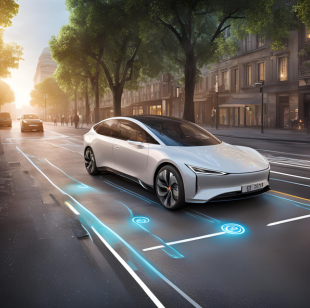Introduction
The rise of electric vehicles (EVs) has sparked a revolution in the transportation industry, driven by the growing need for sustainability and reducing the harmful impact of fossil fuel consumption on the environment. As global concerns over climate change intensify, EVs have emerged as a key solution to curb carbon emissions. However, one significant challenge that still stands in the way of mass EV adoption is the charging infrastructure. Traditional charging methods, though improving, remain insufficient to meet the demands of an increasingly electrified world.
Enter dynamic wireless charging and electrified roads—technologies that have the potential to completely transform the way we think about transportation and charging infrastructure. These innovations offer the promise of seamless, real-time charging while vehicles are in motion, thus eliminating the need for frequent stops or long charging durations.
In this article, we will explore the exciting future of transportation by delving into how dynamic wireless charging and electrified roads work, their benefits, the challenges of scaling these technologies, and how they could shape the future of transportation. Let’s dive into this fascinating journey into the future of mobility.
1. Understanding Dynamic Wireless Charging
Definition and Explanation of Dynamic Wireless Charging
Dynamic wireless charging is an innovative technology that allows electric vehicles (EVs) to charge their batteries while they are in motion. Unlike traditional charging, which requires vehicles to be stationary and plugged into a charging point, dynamic wireless charging uses electromagnetic fields to transfer energy from a charging system embedded in the road to a receiver installed in the vehicle.
This technology operates on principles similar to wireless power transfer (WPT) but with the added complexity of allowing the transfer of energy to vehicles in real-time, as they move along the road. The energy is transferred inductively or via magnetic resonance, both of which rely on electromagnetic fields to transmit energy between two coils—one embedded in the road and one inside the vehicle.
How Dynamic Wireless Charging Differs from Traditional Charging Methods
Traditional EV charging requires vehicles to be parked at a charging station, where they are physically connected to a power source via a charging cable. The process can take anywhere from 30 minutes to several hours, depending on the charging station and battery size.
Dynamic wireless charging, in contrast, eliminates the need for stopping to charge. As EVs drive over roads equipped with wireless charging technology, they continuously charge their batteries. This creates the potential for real-time, uninterrupted power supply while the vehicle is in motion, greatly reducing or even eliminating the need for conventional charging stops.
The main differences are:
- No physical connection: No cables or plugs are needed.
- Continuous charging: EVs can charge while driving, unlike traditional charging methods that require vehicles to be stationary.
- Less time spent charging: Charging can occur over extended periods as vehicles move, reducing downtime for charging.
The Technology Behind Dynamic Wireless Charging
The technology behind dynamic wireless charging is primarily based on inductive charging or magnetic resonance. Both methods involve the transmission of energy via electromagnetic fields between two coils.
- Inductive charging: This method involves two coils: one installed in the road and the other in the vehicle. These coils create a magnetic field that allows the transfer of electrical energy without direct contact. The energy is then converted into usable power by the vehicle’s onboard systems.
- Magnetic resonance: Magnetic resonance is a more advanced form of inductive charging that allows for greater efficiency and longer charging ranges. This method utilizes resonant magnetic fields, which can charge vehicles at higher speeds and over greater distances than traditional inductive charging.
In both cases, the vehicle is equipped with an onboard system to receive and convert the wireless energy into electricity to recharge the battery.
2. The Concept of Electrified Roads
What Are Electrified Roads, and How Do They Work?
Electrified roads are roadways equipped with systems that can deliver power directly to vehicles as they drive. These systems are embedded in the road surface and work in conjunction with the vehicle’s wireless charging system. Electrified roads are essentially the infrastructure that enables dynamic wireless charging to occur on a large scale.
The most common method used in electrified roads is the integration of inductive charging systems beneath the road surface. These systems can be installed in specific lanes or along entire roadways, allowing vehicles to continuously charge as they drive over the charged lanes.
Electrified roads can work in several ways:
- Inductive charging lanes: These lanes are embedded with coils that transfer energy to the vehicle’s charging system.
- Power rails: Similar to trams or trolleybuses, some electrified roads may use conductive rails or strips embedded in the road to supply power directly to electric vehicles.
Electrified roads aim to eliminate range anxiety, the concern that EV drivers have about running out of battery power on long trips. By enabling vehicles to charge continuously while driving, electrified roads can significantly reduce the need for large batteries and frequent charging stops.
The Potential to Power Vehicles in Motion Without Needing to Stop for a Charge
The key benefit of electrified roads is their ability to power vehicles while they are moving. This opens up new possibilities for long-distance travel, urban mobility, and overall EV adoption. Imagine a world where drivers no longer have to stop at charging stations or worry about depleting their battery on long trips.
This continuous charging system also enables vehicles to have smaller batteries, reducing the vehicle’s weight and cost. Instead of relying on massive batteries to cover long distances, vehicles would be able to rely on the road infrastructure for power, thus reducing the need for extensive charging networks.
Examples of Electrified Road Projects and Pilot Programs Around the World
Several projects and pilot programs have already begun testing electrified roads around the world. Some notable examples include:
- Sweden’s eRoadArlanda: This pilot project, launched in 2018, is a 2-kilometer stretch of road where vehicles can charge wirelessly while driving. The system uses inductive charging embedded in the road to power EVs in motion.
- South Korea’s On-road EV charging: South Korea is developing a system of electrified roads where EVs can be charged while driving. This initiative is aimed at making public transportation, such as buses, fully electric without the need for large batteries or charging stations.
- Germany’s Autobahn Charging Lanes: Germany is exploring the integration of electrified lanes along its autobahn to enable trucks and buses to charge on the move. The country is piloting electrified road technologies in several regions.
These projects show the feasibility of electrified roads, and as technology improves, we can expect more widespread implementation.
3. The Integration of Dynamic Wireless Charging with Electrified Roads
How Dynamic Wireless Charging Systems Are Integrated into Electrified Roads
Dynamic wireless charging systems are seamlessly integrated into electrified roads using a combination of embedded inductive charging coils and sophisticated wireless energy transfer technology. The process typically works as follows:
- Embedded charging infrastructure: Charging coils are installed beneath the surface of the road. These coils generate electromagnetic fields that power vehicles equipped with receiving coils.
- Vehicle integration: The vehicle is equipped with a receiver coil, typically located in the undercarriage or near the wheels. This coil captures the energy from the electromagnetic field and converts it into usable power for the vehicle’s battery.
- Energy conversion: The captured energy is fed into the vehicle’s battery management system, where it is stored for use by the vehicle’s electric motors.
Benefits of Continuous Charging While Driving
The primary benefit of continuous charging while driving is the elimination of the need for long stops at charging stations. With electrified roads, the vehicle can drive for longer distances without worrying about depleting the battery, as it will constantly be charging as it moves.
Additionally, continuous charging allows for:
- Extended driving range: Without the need for large batteries, vehicles can travel further on a single charge.
- Smaller and lighter batteries: Because the vehicle doesn’t need to store as much power, the battery can be smaller, lighter, and cheaper to produce.
- Reduced downtime: Vehicles are no longer constrained by the need to stop and charge, improving productivity for commercial fleets and reducing inconvenience for individual drivers.
Real-World Applications and Potential Scalability
While the concept of dynamic wireless charging and electrified roads is still in its infancy, the scalability of this technology is promising. Major infrastructure projects around the world are investing in the research and development of these systems, with pilot programs being tested in different countries. Over time, the technology can be scaled up to entire cities, regions, or even countries, creating a fully integrated electric transport network.
4. Key Benefits of Dynamic Wireless Charging and Electrified Roads
Increased Range for Electric Vehicles
With dynamic wireless charging, the driving range of EVs could be drastically extended. By charging while driving, the vehicle would no longer be limited by battery capacity and the need to stop frequently for charging.
Reduced Need for Large Battery Capacities and Faster Charging Times
The need for large batteries to achieve long driving ranges would be reduced, lowering the cost and weight of EVs. As a result, EVs could have faster acceleration, better handling, and lower manufacturing costs.
Environmental Benefits
By reducing the size of batteries, dynamic wireless charging and electrified roads would help reduce battery waste. Additionally, EVs would be charged using clean energy sources integrated into the power grid, which could significantly reduce greenhouse gas emissions.
Cost Savings and Improved Traffic Flow
Dynamic wireless charging could also reduce the costs associated with establishing a widespread network of charging stations. It could also improve traffic flow by reducing congestion around charging stations and allowing vehicles to continue their journey without needing to stop.
Overcoming Current EV Charging Infrastructure Limitations
The widespread deployment of dynamic wireless charging and electrified roads would alleviate the bottlenecks that currently limit the EV charging infrastructure. With this technology, the need for charging stations could be reduced or eliminated altogether, making EVs much more practical for everyday use.
5. The Challenges and Considerations
Technical Challenges
While dynamic wireless charging and electrified roads are promising technologies, there are technical hurdles to overcome, including:
- Efficiency and power loss: Ensuring high efficiency in wireless power transfer is critical to avoid energy loss during transmission.
- Vehicle compatibility: Vehicles need to be equipped with the necessary systems to receive wireless energy, which may require significant retrofitting of existing EVs.
Regulatory and Safety Concerns
There are also regulatory and safety concerns, particularly with regard to electromagnetic fields and their effects on human health and the environment. Governments will need to establish clear regulations regarding the safe deployment of these systems.
Infrastructure Costs and Implementation Hurdles
The installation of electrified roads and dynamic wireless charging systems requires significant investment in infrastructure. Moreover, retrofitting existing roadways with this technology could present challenges in terms of cost, logistics, and disruption.
Public and Industry Acceptance
The acceptance of new technology is always a challenge, and many consumers and industry stakeholders may be wary of adopting electrified road systems. Convincing the public of the benefits and reliability of these technologies will require significant education and outreach efforts.
6. The Future of Transportation: Vision and Possibilities
How Dynamic Wireless Charging and Electrified Roads Could Shape the Future of EV Adoption
The combination of dynamic wireless charging and electrified roads could eliminate many of the barriers that currently impede EV adoption. With continuous charging capabilities and reduced range anxiety, EVs could become the preferred mode of transportation, leading to widespread adoption.
The Potential for Integration with Autonomous Vehicles and Smart Cities
As autonomous vehicles and smart cities continue to evolve, dynamic wireless charging could integrate seamlessly into the infrastructure, creating a fully autonomous and electrified transportation network. Vehicles could be programmed to drive on charging lanes, ensuring optimal energy use and reducing the need for human intervention.
Long-Term Benefits to Society, the Economy, and the Environment
The long-term benefits of these technologies are immense. They have the potential to reduce global dependence on fossil fuels, lower carbon emissions, improve air quality, and create new economic opportunities in the green technology sector. As the world moves toward sustainable transportation, the widespread implementation of dynamic wireless charging and electrified roads could be pivotal.
Conclusion
In conclusion, the future of transportation is being reshaped by innovative technologies like dynamic wireless charging and electrified roads. These groundbreaking solutions offer the potential to create a seamless, sustainable, and efficient transportation ecosystem that minimizes the need for charging stops and maximizes the use of electric vehicles.
As the technology continues to evolve, we must support research and development efforts to overcome the technical, regulatory, and infrastructure challenges that remain. The transformative potential of these technologies offers a cleaner, greener future, and it is essential to invest in and embrace these innovations for the benefit of society, the economy, and the environment. The road to a sustainable future is paved with electrified roads, and the time to act is now.




